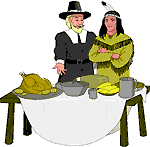 Each November we pause to give thanks for our modern lives. We work 9 to 5, come home and pop a beer from the fridge, and settle down to watch Monday Night Football. We spare few thoughts for the past.
Each November we pause to give thanks for our modern lives. We work 9 to 5, come home and pop a beer from the fridge, and settle down to watch Monday Night Football. We spare few thoughts for the past. Each November we pause to give thanks for our modern lives. We work 9 to 5, come home and pop a beer from the fridge, and settle down to watch Monday Night Football. We spare few thoughts for the past.
Each November we pause to give thanks for our modern lives. We work 9 to 5, come home and pop a beer from the fridge, and settle down to watch Monday Night Football. We spare few thoughts for the past.
If we remember the first Thanksgiving at all, we picture the Pilgrims and Indians living in harmony. Of course, Europeans went on to slaughter the natives and conquer the land, but that's history for you. The Indians simply didn't have the right stuff to develop civilization.
In his book Guns, Germs, and Steel, biologist Jared Diamond demolishes this facile argument. He shows how geographic and ecological differences, not talent or virtue, led the West to domination. Let's see how Diamond's theories apply to the Indians.
Diamond starts by noting the New World's paucity of big domestic mammals. Whereas Eurasia had 13 species, the Americas had only one—the llama, limited to the Andes. Animals such as the bison proved impossible to domesticate widely, as modern attempts have shown.
The Eurasians' animals offered several benefits. They provided protein, wool, and hides. They powered plows, grindstones, and water lifts. They transported people and goods. They served as vehicles of war.
Eurasia also had more plants available to domesticate. The Mediterranean zone alone held 32 species of large-seeded grass, as opposed to 11 in all of the Americas. These developed into crops such as wheat, rice, barley, and sorghum, while the Americas produced only corn.
Domestication propelled an agricultural revolution. People abandoned hunting and gathering to settle down and farm. This increased their productivity and let them experiment with more plants and animals, which led to more people adopting the lifestyle. The factors reinforced each other in a positive feedback cycle.
Superior food production allowed Eurasian communities to grow. From this growth came the "advantages" of civilization. Society became more complex and specialized, requiring centralized government and writing to administer them. Powered by domesticated animals, large-scale trade and warfare demanded wheels and metallurgy. Germs flourished in crowded environments and people developed immunities to them.
Once civilization started in the Fertile Crescent, claims Diamond, there was no turning back. Plants, animals, and ideas spread like wildfire. Neighboring hunter-gatherers were replaced or became food producers themselves.
Not only did Eurasia's centers have better resources, they also had a head start. Whether people crossed a land bridge or emerged from underground, as many native cultures believe, they occupied the Americas millennia after they occupied everywhere else. Once there, more centuries passed before they developed corn from its wild ancestors.
 Geographic barriers hindered the diffusion of domesticated species, technology, political systems, and writing. Among the obstacles were the rain forests of Central America and the deserts of the U.S. Southwest. Crops couldn't survive in different ecological zones as they moved north and south, whereas they could spread east and west over Eurasia.
Geographic barriers hindered the diffusion of domesticated species, technology, political systems, and writing. Among the obstacles were the rain forests of Central America and the deserts of the U.S. Southwest. Crops couldn't survive in different ecological zones as they moved north and south, whereas they could spread east and west over Eurasia.
The consequences were manifold. For instance, while the Phoenician-Greek alphabet came to dominate from England to Indonesia, the Mesoamerican writing systems remained isolated. More dramatically, Diamond states, "The wheels invented in Mesoamerica as parts of toys never met the llamas domesticated in the Andes, to generate wheeled transport for the New World." In other words, progress was fragmented.
The European invaders had the advantages of steel weapons and horses, diseases they were immune to, and literate political systems. When they met the natives on an equal footing, the results were different. Norse attempts to colonize Greenland and Newfoundland failed because Eskimo and Indian locals knew the harsh conditions better. The Pilgrims were on their way to extinction before the natives rescued them.
Given the distribution of geographic, ecological, and biological conditions, the outcome was practically preordained. The West "won" because of inexorable historical trends, not superior cultural values. Those who are counting their blessings should keep that in mind.
More on the myth of Western superiority
The Pristine Myth: Mann asked seven social scientists who they would rather have been in 1491...."[E]very one chose to be an Indian."
Why did the peoples of the New World fail to invent the wheel?
Related links
Uncivilized Indians
Multicultural origins of civilization
Indians gave us enlightenment
Hercules vs. Coyote: Native and Euro-American beliefs
Native vs. non-Native Americans: a summary
Readers respond
"Wow! Your explanation is very thorough in debunking that myth."
"I like the way you've used his work to argue against the 'superior cultural values' perspective."
"The only trouble with this is it is not true."
Bibliography
Some books that support the above arguments:
Recommended Native American Books for All Libraries
Article for Tanasi Journal
November 2005
by Eulala McDowell Pegram
As a Native American retired schoolteacher, curriculum writer and researcher, I have long noted that most libraries often have only a few, or dated, or inaccurate materials people can read to learn about the original inhabitants of this country. Through the years, I have developed a short list of personal favorites that I would highly recommend be in every well-rounded library, both personal and public. The short list that follows is highly selective and personal, but these books, in my opinion, should be in every home, school, public, college, and university library in this country.
It is also my opinion that every education degree applicant in the nation should be required to read and be familiar with the history and contributions of Native Americans contained in these books as a part of their regular class assignments and discussions before receiving a degree in education. Even if this does not happen, perhaps they will affect enough homes to cause some questioning and challenges to errors and omissions in class presentations in all academic classrooms.
There are certainly other books out there that would fill the bill well, also, but I have chosen these because of their scholarly readability, and their thoughtful and thorough research, as well as the reliability of their authors.
I have listed these books below, followed by a short synopsis about each book. This article will be followed by a more complete description of each of the books and its contents at a more or less regular rate of one each month. As near as possible, I will give further references to other material available on the subject at the end of each of the articles.
Stay tuned for some surprises about holes in your education. That was the reaction of most of these authors when they started their research on Native Americans.
NOTES: The rise and fall of many Western hemisphere cultures before the arrival of Europeans and the effects of that contact on those remaining cultures. Jennings is a respected professor, who, at the time this book was written, was Director Emeritus of the Newberry Library Center for the History of the American Indian in Chicago, and Senior Research Fellow of that institution. Written for the general public, the excellent chronology and bibliography sections are at the end of the book.
NOTES: A well written, readable book about how the Native American "cultural, social and political practices transformed the way life is lived throughout the world." Because of its readability, it has been a watershed book setting the record straight on the contributions of Native American, at least for those who have read and enjoyed it. Dr. Weatherford is a respected well- traveled Professor of (cultural) Anthropology at
NOTES: Another excellent book written by Dr. Jack Weatherford (see above). It is a closer look at the "essential role" Native Americans played in the evolution of the
NOTES: This jewel of a relatively small book was researched and germinated while Johansen was in route to obtaining his college degrees, and, indeed, became the basis for his PhD thesis. It is entertainingly written, scholarly, well documented and revolutionary in its subject and scope. It credits the five (later six) Iroquois nations with forming a powerful union, creating a system of rules and living under an ancient, strong, workable government where leaders were servants of the people and individual freedom was stressed and protected, an existing government which Ben Franklin and Thomas Jefferson studied up close and personal and promoted in their roles as founders of another American democracy that John Locke, Cato, and Rousseau only theorized and dreamed about in Europe.
NOTES: An award winning book listing and cross referencing a list of 310 pages of contributions Native Americans have given to the world. Entries are short but very informative and many entries will surprise most people. What also makes this a valuable library edition is these pages are followed by 55 appendix pages listing cultural areas, maps, a glossary, chronology, linguistic groups, bibliography, geographical cultural areas, entries by subject, and an excellent index.
NOTES: This is one of many excellent books on Native American biographies. I selected this one because of the great number of people it includes, the years it covers and the respected writers. Entries are short but give good information. If one is doing in-depth research on an individual, they would need to go to a book with more information (most entries have a For More Information references at the end), but this one is impressive in its overall scope and scholarly entries. Each entry includes the individual's name, English name, tribe, and dates of life. Entries also include some non-Indians who are, or were, important to Native American history.
NOTES: With a copyright date of 2005, this new book is a stellar example of a well researched book. I particularly liked Mann's method of couching his research in the context of how he conducted that research. It is rich with names of his Native guides, local contacts and people he talked with. He also has a good appreciation of the impossibility of one person's ability to report all the material because of its sheer volume. Some of his findings included that, before contact, there were probably more people here than in all of Europe, the earliest cities here were thriving before the pyramids were built, and that the Aztec capital of Tenochtitlan "was greater in population than any contemporary city in Europe at that time (and it) had running water, beautiful botanical gardens, and immaculately clean streets," unlike any capital in Europe. He quotes the journal Science which described the development of corn as "man's first, and perhaps the greatest, feat of genetic engineering." This is a surprising and much welcomed book written in a style that laymen can understand and appreciate and professionals can respect. Mann is an award-winning writer, including two top awards for scientific writing.
Related links
The best Indian books
|
. . . |

|
All material © copyright its original owners, except where noted.
Original text and pictures © copyright 2007 by Robert Schmidt.
Copyrighted material is posted under the Fair Use provision of the Copyright Act,
which allows copying for nonprofit educational uses including criticism and commentary.
Comments sent to the publisher become the property of Blue Corn Comics
and may be used in other postings without permission.